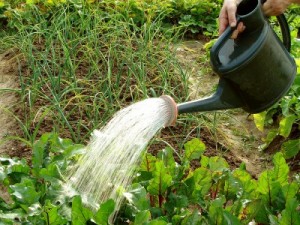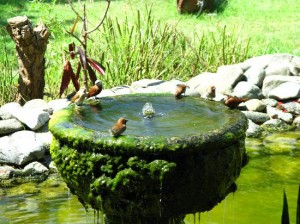
 Whether you believe in climate change and global warming or not, it seems like we’re in for another very dry hot summer, with temps this hot, this early on in Spring concerning many experienced gardeners.
Whether you believe in climate change and global warming or not, it seems like we’re in for another very dry hot summer, with temps this hot, this early on in Spring concerning many experienced gardeners.
It only takes a couple of such hot days to heat stress your garden without the proper pre and post care of your soil, plants, trees and life. If you know a certain day coming up will be extremely hot, or a hotter week is in store, a little prep and care goes a long way to protecting your gardens.
Here’s a few easy things you can do to help:
1. Thicker mulching on your garden beds in the hotter months prevents and minimises water evaporation and heat stress. Lighter mulching in colder months allows the soil and life to receive more warmth.
2. The day before really hot days, water your gardens more deeply. A good deeper soaking water, within reason, makes a big difference. And then on the really hot days, get up extra early and give your gardens a light watering to prep them for the day. This requires some common sense, though, as too much water is just as bad as too little, and some plants require more or less water.
3. At the end of extremely hot days, give your garden another watering, to refresh your plants and trees and cool the soil. This is especially important on hot windy days. Wind will dry plants out very fast and can ‘burn’ foliage.
4. If you can only water once a day, a good soaking water in the mornings is best, especially to prevent unwanted mould, pests and diseases that attack wet humid plants at night. Also try to ‘ground water’ – water your soil and base of plants, rather than overhead watering. I do this in the mornings, and then if I water lightly again in the afternoons of really hot days, I lightly water overhead to cool plants.
5. Place a few sticks or stakes throughout your garden beds, at least 50cm high, and on the mornings of really hot days, drop some shadecloth or old porous sheets or curtains over the sticks. This will prevent and minimise sun stress on your plants and evaporation, especially younger plants and leafy veggies and herbs. Do not lay cloth or sheets directly on your plants. Make sure some air space is between the garden bed and the shading material. I’ve collected lots of rolls and offcuts of shadecloth from kerbsde pickups over recent years, which I use for this purpose … and it’s cost me nothing. I also use old lacy curtains for shade on really hot days.
6. Remember that your plants and trees (and animals) are just like us humans. They get dehydrated and will suffer, or even die, without adequate water and shade on very hot days. Heat stress and lack of water can take many plants and trees beyond the point of recovery. There are also countless beneficial microorganisms and small animals, birds, insects, lizards and frogs in your garden, all doing a great job. Regular watering and providing small ‘watering holes’ for them is essential for their survival.
 Simply place some old dishes and bowls from your kitchen (or an op shop) around your garden beds, under more shady plants and keep topped up with water. Dig them in to ground level. Place some bird baths and waterers around your gardens also in shady spots for birds and insects.
Simply place some old dishes and bowls from your kitchen (or an op shop) around your garden beds, under more shady plants and keep topped up with water. Dig them in to ground level. Place some bird baths and waterers around your gardens also in shady spots for birds and insects.
If you’re new to gardening, effective watering takes a little time to master, but isn’t rocket science and becomes intuitive fairly fast. Get to know your garden and everything in it. While more time-consuming, I personally prefer hand watering with a hose, as it develops a more intimate relationship with each garden bed, each section of plants and their water needs, and even individual plants and trees. It also gives me an opportunity to check garden progress, see what needs harvesting, what might be thriving or struggling, and generally unwind while dreaming a little of edible things to come.
The main thing to remember is, we are now heading into the warmer months, Spring and Summer, and from all indications, a long hot dry summer. So it makes sense to prep your gardens well now – your soil, mulching, plant choices, shade plants and trees, get shadecloth ready, make shading trellises around your garden with shady plants growing on them, especially overhead and on western sides of gardens. A little smart prep will go a long way to ensuring you continue to grow strong healthy plants and food throughout the hotter months.
Happy gardening!
